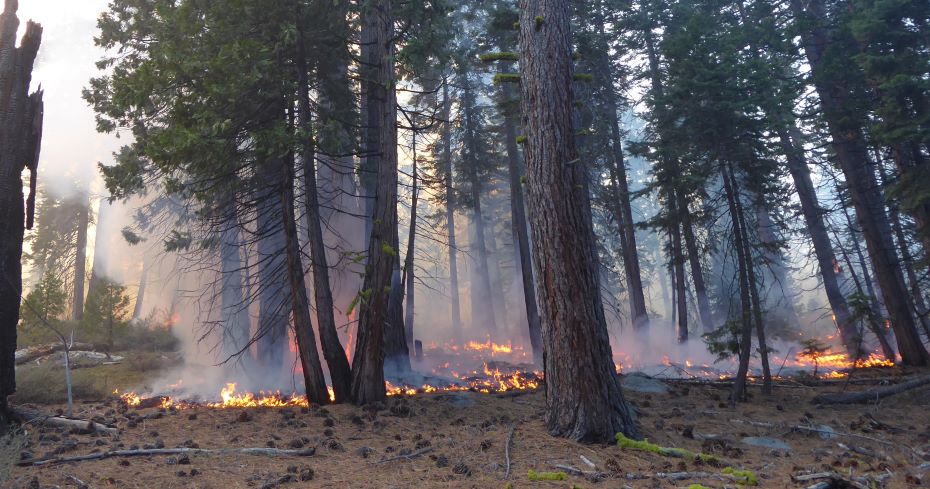 By Kathleen McIntyre, Ph.D.
By Kathleen McIntyre, Ph.D.
Special for the Tahoe Mountain News
Tahoe’s forests influence our lives in many ways. They perfect Tahoe’s scenery, offer peacefulness on a hike, and form the cornerstone of a functioning ecosystem where a healthy forest supports a healthy lake. The ever-growing threat of wildfire in the basin has become just as much a part of our life in the forest.
For thousands of years, the forests in the Lake Tahoe Basin took care of themselves. Low intensity fires crept through the forests, clearing underbrush and thinning tree stands. In the 19th century, pioneers clear-cut the basin’s forests, responding to a need for timber in the silver mines of the Comstock Lode. Today, Tahoe’s forests are overcrowded and littered with dead and dying trees making them an easy target for catastrophic wildfire.
Changing this is a massive undertaking in which everyone plays a role, and incredible progress is being made at all levels. Following the devastating Angora Wildfire in 2007, the Tahoe Regional Planning Agency (TRPA) has maintained sharp focus on helping improve basin-wide coordination, streamlining policies, and significantly ramping up public funding for forest health projects.
To date, Tahoe Fire and Fuels Team (TFFT) partners have reduced forest fuels across more than 92,000 acres, with 71,000 acres of that since the Angora Fire. Some of these projects helped firefighters save Lake Tahoe from the 221,000-acre Caldor Fire just 24 months ago. Since the Caldor, there is a new tempo, advancements in strategy, and expanded coordination around evacuation preparedness that are leading the basin forward.
Forest Resilience
As climate change continues to alter Tahoe’s ecosystem, traditional fuel reduction is being scaled up. TFFT partners continue to plan and prioritize fuels treatments in the wildland-urban interface, where neighborhoods meet forests. Together we are more than halfway to their goal of completing an additional 22,000 acres of treatments in these areas by 2025.
Strategies are also being broadened in alignment with the National Cohesive Fire Management Strategy to include more use of prescribed fire, among others. Over the past two years, 2,100 acres have been treated by prescribed fire, including understory burns and burn piles.
Power Line Resilience Corridors
In the era of mega-fires and increasingly powerful storms, utility providers on both sides of the lake are working with public land managers to increase clearance around high-voltage lines while also conducting fuels treatments in the same zones. Last year, utility companies worked with TFFT partners to treat 570 acres of power line resilience corridors in Nevada and more than 300 acres in California, where an additional 500 acres are planned. This new partnership and innovative approach to forest resilience requires seeing the forest fire for the trees and recognizing that safety goals can be achieved while also improving and protecting the integrity of the forest.
Homes and Neighborhoods
Removing excess vegetation on individual lots is also an important piece of the puzzle. Fire agencies conducted a record 7,960 defensible space inspections last year to give homeowners a plan to make their properties safer. Since 2008, inspectors have conducted a whopping 63,000 evaluations. Public agencies have finished initial treatments on more than 7,000 conservation lots spread throughout Tahoe neighborhoods and continue to actively manage these open spaces. More property owners are acting together as well. The Tahoe Network of Fire Adapted Communities has grown to 24 neighborhoods that are coordinating defensible space and evacuation preparedness, with some getting access to better insurance rates.
Evacuation Preparedness and Coordination
Concerns about emergency preparedness and evacuation are reverberating throughout Lake Tahoe communities. Our hearts go out to the residents of Lahaina, Hawaii and the many others affected by recent disasters. The tragedy on Maui hit especially close to home with the Caldor evacuation so fresh in our memory. Earlier this year, TRPA joined regional emergency response and fire agencies to improve evacuation coordination and learn where we can provide the greatest assistance.
To help get people out of the basin safely in an emergency, TRPA is learning that we must maintain our supportive role working with local law enforcement. We will also continue working with partners to secure funding to keep up forest fuel reduction work along evacuation corridors and around critical utility and communications infrastructure. Upgrading water infrastructure to improve fire suppression is also a major priority of the Lake Tahoe Environmental Improvement Program.
Increasing Capacity for a Healthy Forest
TFFT is focused on increasing capacity to continue to improve forest health and address the worsening impacts of climate change. Not only through additional funding, but also by finding more solutions for biomass utilization and material transport, expanding the use of prescribed fire, and increasing investment in the local fire and forestry workforce. Examples of these can already be seen in the new sawmill in Carson City, the successful 13-acre understory burn conducted in June by the USDA Forest Service on South Shore, and the new forestry program at Lake Tahoe Community College that is guiding graduates to high-demand jobs in the region.
TRPA and our partners are committed to reducing wildfire risk and restoring our forests to a more natural and safer condition. With everyone’s help, we can preserve the best traits of Tahoe’s forests while keeping communities safe and protecting the lake. Find out more at tahoelivingwithfire.com.
Dr. Kathleen McIntyre is the forest health and Environmental Improvement Program manager for the Tahoe Regional Planning Agency. She holds a Ph.D. in forest sciences from Colorado State University.

